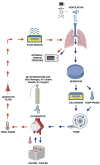The impact and relevance of techniques and fluids on lung injury in machine perfusion of lungs
- PMID: 38510260
- PMCID: PMC10950925
- DOI: 10.3389/fimmu.2024.1358153
The impact and relevance of techniques and fluids on lung injury in machine perfusion of lungs
Abstract
Primary graft dysfunction (PGD) is a common complication after lung transplantation. A plethora of contributing factors are known and assessment of donor lung function prior to organ retrieval is mandatory for determination of lung quality. Specialized centers increasingly perform ex vivo lung perfusion (EVLP) to further assess lung functionality and improve and extend lung preservation with the aim to increase lung utilization. EVLP can be performed following different protocols. The impact of the individual EVLP parameters on PGD development, organ function and postoperative outcome remains to be fully investigated. The variables relate to the engineering and function of the respective perfusion devices, such as the type of pump used, functional, like ventilation modes or physiological (e.g. perfusion solutions). This review reflects on the individual technical and fluid components relevant to EVLP and their respective impact on inflammatory response and outcome. We discuss key components of EVLP protocols and options for further improvement of EVLP in regard to PGD. This review offers an overview of available options for centers establishing an EVLP program and for researchers looking for ways to adapt existing protocols.
Keywords: EVLP; PGD; ex vivo; organ perfusion; techniques; transplantation.
Copyright © 2024 Ponholzer, Dumfarth, Krapf, Pircher, Hautz, Wolf, Augustin and Schneeberger.
Conflict of interest statement
The authors declare that the research was conducted in the absence of any commercial or financial relationships that could be construed as a potential conflict of interest.
Figures







Similar articles
-
Extended post-ex vivo lung perfusion cold preservation predicts primary graft dysfunction and mortality: Results from a multicentric study.J Heart Lung Transplant. 2020 Sep;39(9):954-961. doi: 10.1016/j.healun.2020.05.002. Epub 2020 May 16. J Heart Lung Transplant. 2020. PMID: 32475748 Clinical Trial.
-
The Conversional Efficacy of Ex Vivo Lung Perfusion and Clinical Outcomes in Patients Undergoing Transplantation of Donor Lungs by Ex Vivo Lung Perfusion: A Meta-Analysis.Ann Transplant. 2019 Dec 27;24:647-660. doi: 10.12659/AOT.919242. Ann Transplant. 2019. PMID: 31879416 Free PMC article.
-
Incidence and severity of primary graft dysfunction after lung transplantation using rejected grafts reconditioned with ex vivo lung perfusion.Eur J Cardiothorac Surg. 2014 Nov;46(5):789-93. doi: 10.1093/ejcts/ezu239. Epub 2014 Jul 24. Eur J Cardiothorac Surg. 2014. PMID: 25061216
-
Ex vivo lung perfusion to improve donor lung function and increase the number of organs available for transplantation.Transpl Int. 2014 Jun;27(6):553-61. doi: 10.1111/tri.12295. Epub 2014 Apr 4. Transpl Int. 2014. PMID: 24628890 Free PMC article. Clinical Trial.
-
Ex vivo lung perfusion: recent advancements and future directions.Front Immunol. 2025 Feb 24;16:1513546. doi: 10.3389/fimmu.2025.1513546. eCollection 2025. Front Immunol. 2025. PMID: 40066445 Free PMC article. Review.
References
Publication types
MeSH terms
LinkOut - more resources
Full Text Sources
Medical
Miscellaneous

